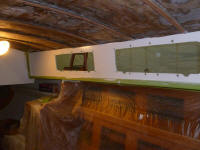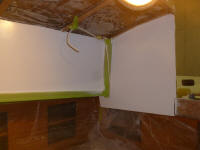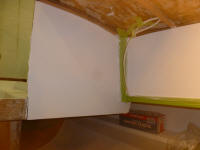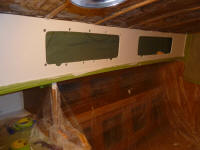
110 Cookson Lane | Whitefield, ME 04353 | 207-232-7600 | tim@lackeysailing.com
Snow Lily | Friday, December 21, 2012
I was pretty happy with how the paint was looking on most parts of the interior, but the cabin trunk sides--made from wood--needed another coat, which I'd anticipated all along. So after lightly sanding those areas and cleaning up, I applied a third coat of the semi-gloss white paint. I looked forward to removing all the tape and messy plastic.
One project that'd be coming up soon would be to build the cabinet for the new Sardine wood stove in the main cabin. The stove itself wouldn't be on hand for a while, thanks to the limited casting and finishing schedule of the manufacturer, but the cabinet could be made ready in advance, and represented one of the last major structures yet to be started. Along with the cabinet, there'd also be a requirement for heat shielding against the bulkhead, behind the stovepipe, so in order to get ready to order that particular piece, I set up my cardboard mockup of the stove base that I'd created months back and made some measurements of the heat shield area.
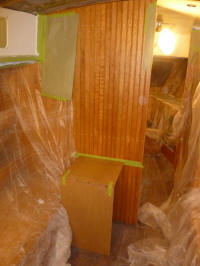
It was a good time to prepare some stock for the cabinet doors. From 4/4 cherry, I milled a series of 1-1/2" wide strips, then cut them to the proper lengths for the rails and stiles for all the cabinet doors required, leaving a few sections in their raw lengths pending final details of the locker doors themselves, notably the larger openings located in a few bulkheads. I'd start building the doors soon, incrementally as dictated by available clamps and time.
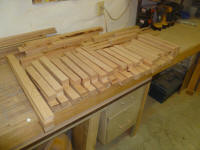
Another significant round of stock preparation was required, in order to mill the strips for the forward cabin ceiling (hull liner). I had a supply of 5/4 cherry stock that I'd originally ordered for the beadboard in the main cabin, which we ultimately had milled and sourced from a specialty shop, so this material was perfect for the ceiling. I'd used bits and pieces of the heavier stock elsewhere, but seven boards remained--all significantly overlong at 11', but I'd trim the excess length to save for other purposes.
In any event, the first step to prepare the stock was to sand both faces using 80, 120, and 220 grit paper, to smooth the planer marks and otherwise prepare the surface for final finishing. It's much easier to sand the uncut boards than to individually sand all the small strips after milling. This chore took me through the end of the day; I left the actual milling for next time.
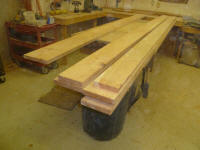
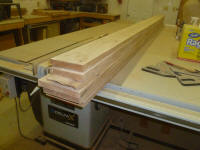
Total Time on This Job Today: 7.25 hours

